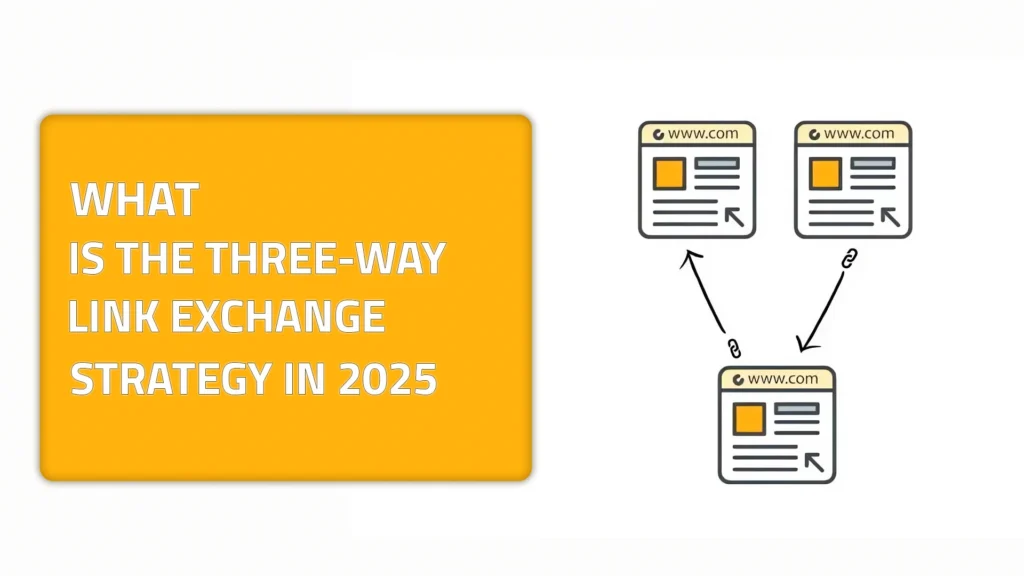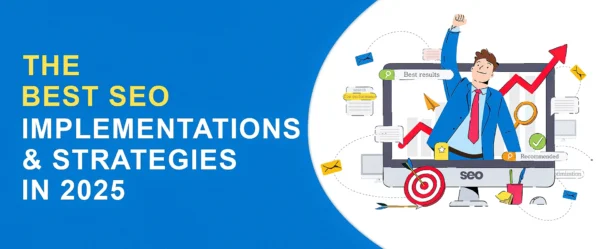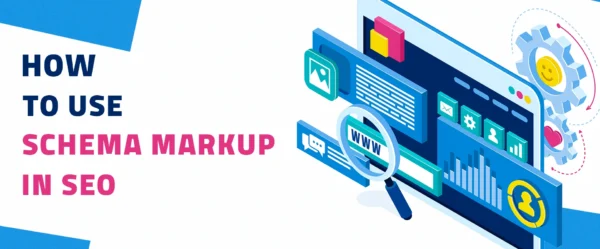Link building in SEO has always been a cornerstone of the whole SEO realm. However, the strategies used have evolved greatly over the years. Back in the day, direct link exchanges that involved trading links between two websites were all there was in the process of exchanging hyperlinks. However, as Google’s algorithms became more sophisticated and enhanced, direct exchanges started losing their effectiveness. Nowadays they are often viewed as manipulative means of exchanging links. This is where the three-way link exchange comes into play, ensuring an ethical and correct link exchange. In this guide we will delve deeper into this topic to understand more about how to exchange links in an effective way.
In 2025, innovative strategies like the three-way link exchange are crucial to staying competitive in the crowded digital space. This technique involves three websites. This is where Site A links to Website B, and Site B links to Website C, and Website C links back to Website A. It’s a clever way to make link exchanges appear more natural to search engines. All while avoiding reciprocal patterns that can raise red flags. Why does this matter in 2025? As search algorithms prioritize quality and context over quantity, staying ahead with creative, ethical methods becomes essential. In this article, we’ll break down the three-way link exchange strategy, its benefits, and how to implement it effectively.
Understanding the Basics of Three-Way Link Exchange
So, what exactly is a three-way link exchange? Understanding the basics will help you understand that this is an efficient strategy. Think of it as a savvy triangle dance in the world of SEO. Unlike the classic two-way link exchange, where two websites engage in a “you give me something and I’ll give you another” arrangement. However, with a three-way link exchange, you get to bring a third player into the mix, making the whole process more intriguing and less predictable. Another name for this process is called ABC link exchange. Why? Well, let me explain it through an example that may help you understand. Here’s how it works:
- Site A links to Website B
- Website B links to Website C
- Site C links back to Website A
Why is this approach a big deal? Why do people see that it is important? Well, search engines like Google love backlinks that look organic and come from varied sources. A direct “You link to me, I’ll link to you” scenario can set off alarm bells for algorithms, but a three-way exchange cleverly avoids this trap. It’s like hosting a dinner party where no one sits directly across from their partner—fresh, unexpected, and perfectly balanced.
Here’s an Example for Better Understanding
Imagine this in action: a small business blog, a travel website, and a tech blog. Three blogs that may not relate to each other but they can do wonders when they decide to collaborate. The travel website links to an insightful article on the tech blog about gadgets for travelers. The tech blog, in turn, highlights a productivity tip from the small business blog.
Finally, the small business blog features the travel website in a “Top Destinations for Entrepreneurs” post. I know that the three may not be so relevant, yet they can find a certain link between each other that will help them enhance their visibility, exposure, and link exchange strategy. Each participant benefits from increased visibility, improved credibility, and a stronger backlink profile, all without raising Google’s suspicion. In order to summarize this, it’s a smart strategy that’s as ingenious as it is practical. Moreover, it’s significantly more enjoyable to implement than your typical link exchange! Additionally, this strategy is one that helps you stay relevant in today’s market and SEO realm.
Why Choose Three-Way Link Exchanges in 2025?
What makes the three-way link exchange particularly appealing in 2025? The SEO landscape is ever-changing, with search engines constantly updating algorithms to detect and penalize manipulative tactics. Additionally, this strategy helps weed out low-quality backlinks from irrelevant sites. Since the triangle of links encourages collaboration among like-minded websites, you’re less likely to end up tangled in a web of spammy, irrelevant connections. When you keep things clean and clever, three-way exchanges let you build genuine authority without resorting to SEO tricks that scream “manipulation.” Three-way exchanges offer an innovative solution that aligns with modern SEO principles.
Let me give you some reasons why they stand out:
- Enhanced Link Diversity: Unlike direct exchanges, this strategy creates a more varied and natural backlink profile.
- Improved Search Rankings: Backlinks remain a major ranking factor, and three-way exchanges can help boost domain authority without triggering penalties.
- Greater Collaboration Opportunities: These exchanges foster partnerships among websites in related niches, expanding reach and audience engagement.
For example, a fitness blog, a nutrition website, and a wellness app could engage in a three-way link exchange. Not just because it’s better as they’re relevant but also because of the empowerment that they’ll get. This not only strengthens their link profiles but also creates meaningful connections that enhance credibility in their respective fields.
As competition in the digital sphere intensifies, things change. And you have to start adopting forward-thinking strategies like three-way exchanges. That is because such strategies are becoming essential for staying ahead of the market’s competition.
How to Identify Reliable Partners for a Three-Way Link Exchange
Finding the right partners for a three-way link exchange is crucial for its success. But how do you identify trustworthy collaborators?
You can start by looking for the following qualities:
- Relevant Niches: Ensure potential partners operate within or complement your industry.
- Strong Domain Authority: Aim for websites with good metrics to maximize the impact of the exchange.
- Clean Backlink Profiles: You can use tools like Ahrefs or SEMrush to search and verify their backlink history and check if they were ever involved in any spammy practices.
Here are some red flags that you should be aware of:
- Be careful of sites with excessive outbound links. These sites can be included in a web of spammy experiences.
- Monitor and focus on sites that may have unnatural link growth patterns. Again, this indicates that they may not be so ethical with their link-exchanging processes.
- Don’t ever be overly pushy or communicate with sites that you want to link to in a vague way.
To streamline the process, platforms like linkexchange.ai can connect you with credible partners and domains with high domain authority. All while automating the vetting process efficiently. This ensures that your exchanges are both strategic and secure.
Implementing a Successful Three-Way Link Exchange Strategy
When it comes to three-way link exchanges, execution is crucial. Think of it as planning a perfect dinner party; you need the right mix of guests, a clear plan, and good communication to keep everyone happy and engaged. However, you will need that in a digital context here. Here are some steps that you need to do in order to succeed:
- Research and Shortlist: The first step is finding the right partners, just like deciding who gets an invite to your party. Use tools and platforms to scout websites that align with your niche and share your vision for a win-win collaboration.
- Pitch Your Value: Once you’ve found potential partners, it’s time to send that invite! Craft a personalized outreach email that’s less “corporate jargon” and more “Look what we can achieve together!” Emphasize the advantages of working together and explain why your partnership would be a perfect fit for SEO.
- Define Terms Clearly: Before the party begins, set the ground rules. Decide on link placement, anchor text, and timelines. The clearer the terms, the fewer hiccups later.
- Monitor Performance: The party doesn’t end when everyone leaves—track the success of your efforts. Use analytics tools to see how your new links are performing and tweak your strategy as needed.
Transparency is a crucial component in the past success of link exchanges. Be open about your goals. Because clarifying your purposes has never been more important than this. Additionally, maintain open lines of communication and cultivate trust among your partners. For example, imagine a small e-commerce store teaming up with a chic fashion blog and a savvy product review site. By outlining mutual benefits and maintaining a clear agreement, they’re not just exchanging links, but they’re building relationships that can flourish for years. If you combine effort and enjoyment, your three-way link exchange can become the topic of conversation in the SEO community. So, ready to host your link-building soirée?
Common Challenges and How to Overcome Them
Every strategy presents its own set of challenges, and three-way link exchanges are no different. They function similarly to a high-stakes group project, requiring everyone to contribute to its success. A common question that pops up is, “How do you ensure trust among partners?” It’s a legitimate concern—after all, nobody wants to appear foolish in an SEO game. Miscommunication, unmet expectations, or a partner suddenly ghosting you can lead to broken links and even dreaded Google penalties.
So, how do you keep the trust alive and ensure everyone sticks to their part of the bargain? Here’s a cheat sheet (one that I wish someone created for me):
- Put It in Writing: Use contracts or written agreements to clearly outline responsibilities, because nothing says “I mean business” like an official document. In this document, you have to make sure that you use clear language and a professional tone of voice.
- Use Tools Like a Pro: When it comes to tracking and verifying live links, third-party tools are invaluable. Think of them as your digital helper for the links verification process.
- Inspect What You Expect: Regularly review link placements. That is, to make sure everyone’s still playing fair. Regularly conducting a quick audit can significantly reduce the likelihood of unpleasant surprises.
Don’t overlook the significant issue of Google penalties. Despite the safety of three-way exchanges compared to other SEO amusement parks, poor execution can still lead to trouble. Avoid linking to shady or irrelevant sites, no matter how tempting their pitch might seem. Always remember: quality trumps quantity. If you wouldn’t want to show a link to your boss, Google probably won’t like it either. Maintain a clean and ethical approach to avoid any SEO penalties.
Best Practices for 2025
Want to stay ahead in 2025? Well, buckle up, because here are some best practices that will give your SEO strategy the boost it deserves! First up: Keep It Relevant. Partnering with websites that align with your niche is non-negotiable. It’s not just about having a lot of links; it’s about having the right ones! Imagine trying to collaborate with a pet food blog when you run a tech startup. Not exactly the dream team, right? Your link exchange partners should share similar interests and target audiences, so it’s a win-win for everyone involved.
Next, Diversify Your Strategy. Avoid concentrating all your SEO efforts in one area! Although three-way link exchanges are beneficial, it’s crucial to diversify your SEO strategies. Combine these exchanges with other methods like guest posting, content marketing, and influencer collaborations. The more diverse your tactics, the stronger and more natural your backlink profile becomes. Think of it as a balanced diet for your SEO; don’t just feast on one food group!
Finally, Leverage Technology. In 2025, you don’t need to do it all manually! Use tools like our domain linkexchange.ai to simplify the process. Not only does this help you find the best partners, but it also ensures that your link exchanges are ethical and effective. It’s like having a trusted GPS guiding you through the complicated SEO terrain. When you stay adaptable and ethical, you’ll be able to ride the wave of link-building success without wiping out. So go ahead, get strategic, get tech-savvy, and watch your credibility, visibility, and your rankings soar to new heights!
To Conclude This…
The three-way link exchange strategy is a powerful tool for navigating the complex SEO landscape of 2025. When you create diverse, natural backlink profiles, this method will help you improve rankings, build authority, and foster meaningful collaborations.
As the digital world continues to evolve, strategies like this will play a crucial role in maintaining competitiveness. However, you must be sure that you find the right platforms or tools that will help you throughout your process. Are you ready to elevate your link-building game? Discover how platforms like linkexchange.ai can help you connect with reliable partners, simplify processes, and achieve measurable results. Start building smarter, not harder. Take the first step now and don’t delay your website’s success any further!









